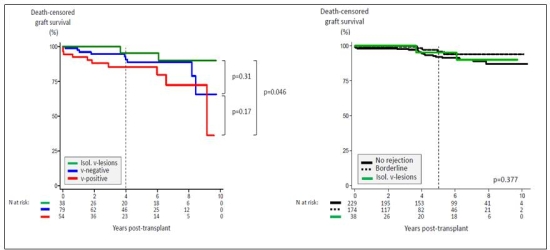Clinical Significance of Isolated v-Lesions in Kidney Transplantation
1Transplantation Immunology and Nephrology, University Hospital Basel, Basel, Switzerland
2Institute for Pathology, University Hospital Basel, Basel, Switzerland.
Meeting: 2018 American Transplant Congress
Abstract number: D184
Keywords: Graft survival, Prognosis, Rejection
Session Information
Session Name: Poster Session D: Kidney: Acute Cellular Rejection
Session Type: Poster Session
Date: Tuesday, June 5, 2018
Session Time: 6:00pm-7:00pm
 Presentation Time: 6:00pm-7:00pm
Presentation Time: 6:00pm-7:00pm
Location: Hall 4EF
Background: Arteritis without significant tubulo-interstitial inflammation (v1-3, but i≤1 and t≤1) is referred by the 10th Banff conference as 'isolated v-lesions'. The clinical significance of these lesions is unclear. The aim was to investigate the frequency and impact on long-term graft survival of these lesions appearing within the first year after kidney transplantation.
Methods: In this retrospective analysis, 574 recipients with different HLA-risk were included (AB0-compatible without pre-transplant HLA-DSA (n=419), with pre-transplant HLA-DSA (n=103), and AB0-incompatible (n=52)), who underwent ≥1 biopsies (protocol or indication) within the first year post-transplant. Based on the result of the index biopsy (defined as the most intense rejection episode), recipients were divided into the following groups (i) rejection, (ii) only borderline lesions, and (iii) no rejection. Based on the absence/presence of vascular involvement the rejection group was subdivided into 3 subgroups: (i) rejection without vascular involvement (v-negative), (ii) rejection with vascular involvement (v- positive), and (iii) isolated v-lesions.
Results: Out of 171 patients with rejection, 38 (22%) presented with isolated v-lesions. Within a median follow up of 4 years, the death-censored graft survival was significantly inferior in the v-positive versus isolated v-lesions group (p=0.046). Isolated v-lesions showed a favorable long-term graft survival, similar to the no rejection and borderline group (p=0.377).  In our cohort, recipients with isolated v-lesions were treated with steroids (25/38, 66%), T-cell depleting agents (8/38, 21%), or remained untreated (5/38, 13%).
In our cohort, recipients with isolated v-lesions were treated with steroids (25/38, 66%), T-cell depleting agents (8/38, 21%), or remained untreated (5/38, 13%).
Conclusions: The early appearance of isolated v-lesions do not negatively affect long-term graft survival when treated with currently available antirejection treatments. However, the impact on long-term outcome is unknown if these lesions remain untreated.
CITATION INFORMATION: Georgalis A., Wehmeier C., Hirt-Minkowski P., Hönger G., Hopfer H., Steiger J., Schaub S., Amico P. Clinical Significance of Isolated v-Lesions in Kidney Transplantation Am J Transplant. 2017;17 (suppl 3).
To cite this abstract in AMA style:
Georgalis A, Wehmeier C, Hirt-Minkowski P, Hönger G, Hopfer H, Steiger J, Schaub S, Amico P. Clinical Significance of Isolated v-Lesions in Kidney Transplantation [abstract]. https://atcmeetingabstracts.com/abstract/clinical-significance-of-isolated-v-lesions-in-kidney-transplantation/. Accessed January 7, 2026.« Back to 2018 American Transplant Congress
